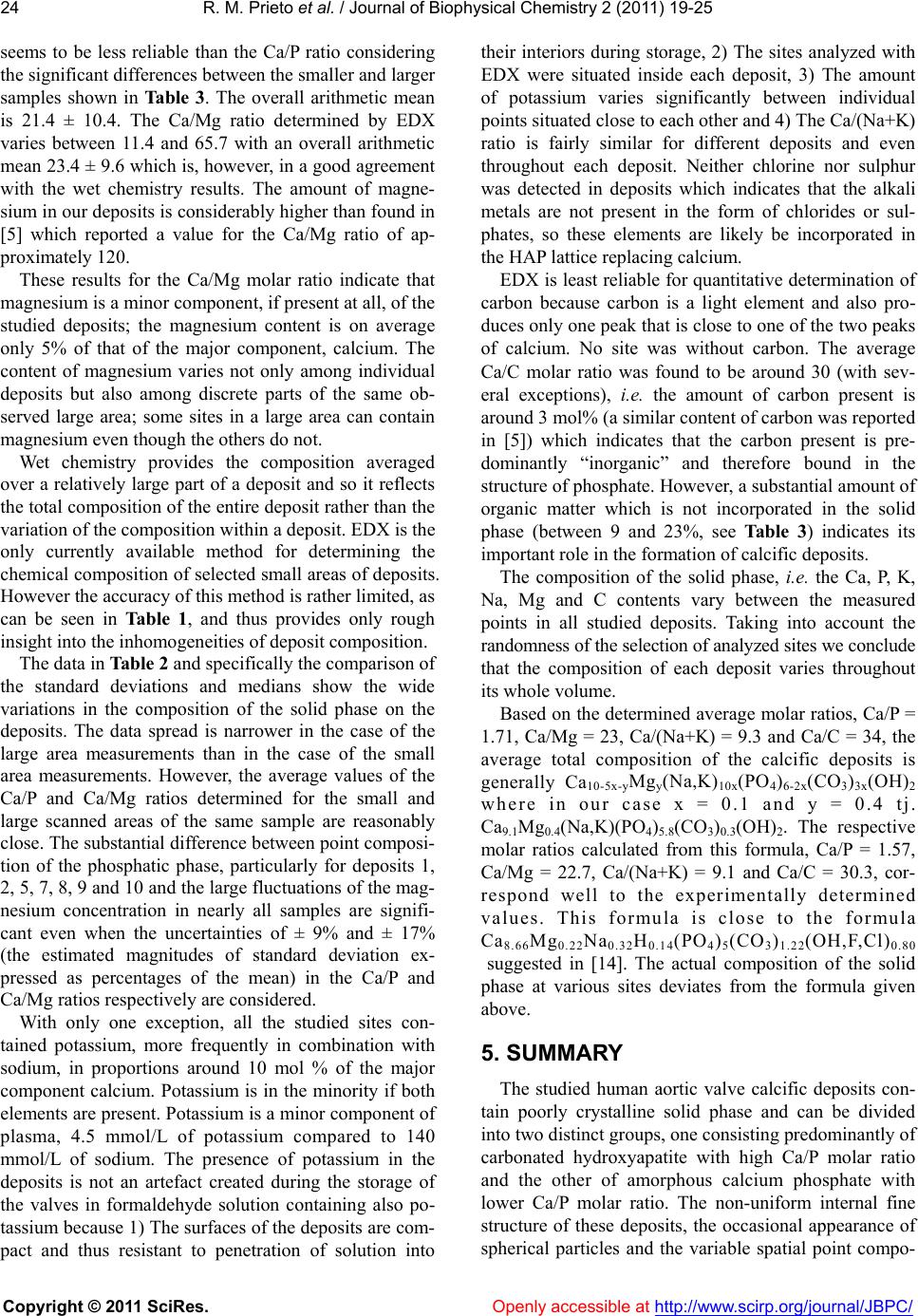
R. M. Prieto et al. / Journal of Biophysical Chemistry 2 (2011) 19-25
Copyright © 2011 SciRes. Openly accessible at http://www.scirp.org/journal/JBPC/
24
seems to be less reliable than the Ca/P ratio considering
the significant differences between the smaller and larger
samples shown in Ta bl e 3 . The overall arithmetic mean
is 21.4 ± 10.4. The Ca/Mg ratio determined by EDX
varies between 11.4 and 65.7 with an overall arithmetic
mean 23.4 ± 9.6 which is, however, in a good agreement
with the wet chemistry results. The amount of magne-
sium in our deposits is con siderably high er than found in
[5] which reported a value for the Ca/Mg ratio of ap-
proximately 120.
These results for the Ca/Mg molar ratio indicate that
magnesium is a minor component, if present at all, of the
studied deposits; the magnesium content is on average
only 5% of that of the major component, calcium. The
content of magnesium varies not only among individual
deposits but also among discrete parts of the same ob-
served large area; some sites in a large area can contain
magnesium even though the others do not.
Wet chemistry provides the composition averaged
over a relatively large part of a deposit and so it reflects
the total compositio n of the entire depos it rather than the
variation of the composition within a deposit. EDX is the
only currently available method for determining the
chemical composition of selected small areas of deposits.
However the accuracy of this method is rather limited, as
can be seen in Table 1, and thus provides only rough
insight into the in homogeneities of deposit composition.
The data in Table 2 and specifically the comparison of
the standard deviations and medians show the wide
variations in the composition of the solid phase on the
deposits. The data spread is narrower in the case of the
large area measurements than in the case of the small
area measurements. However, the average values of the
Ca/P and Ca/Mg ratios determined for the small and
large scanned areas of the same sample are reasonably
close. The substantial difference b etween po int composi-
tion of the phosphatic phase, particularly for deposits 1,
2, 5, 7, 8, 9 and 10 and the large fluctu ations of the mag-
nesium concentration in nearly all samples are signifi-
cant even when the uncertainties of ± 9% and ± 17%
(the estimated magnitudes of standard deviation ex-
pressed as percentages of the mean) in the Ca/P and
Ca/Mg ratios respectively are consid ered.
With only one exception, all the studied sites con-
tained potassium, more frequently in combination with
sodium, in proportions around 10 mol % of the major
component calcium. Potassium is in the minority if both
elements are present. Potassium is a minor component of
plasma, 4.5 mmol/L of potassium compared to 140
mmol/L of sodium. The presence of potassium in the
deposits is not an artefact created during the storage of
the valves in formaldehyde solution containing also po-
tassium because 1) The surfaces of the deposits are com-
pact and thus resistant to penetration of solution into
their interiors during storage, 2) The sites analyzed with
EDX were situated inside each deposit, 3) The amount
of potassium varies significantly between individual
points situated close to each other and 4) The Ca/(Na+K)
ratio is fairly similar for different deposits and even
throughout each deposit. Neither chlorine nor sulphur
was detected in deposits which indicates that the alkali
metals are not present in the form of chlorides or sul-
phates, so these elements are likely be incorporated in
the HAP lattice replacing calcium.
EDX is least reliable for quantitative determinatio n of
carbon because carbon is a light element and also pro-
duces only one peak that is close to one of the two peaks
of calcium. No site was without carbon. The average
Ca/C molar ratio was found to be around 30 (with sev-
eral exceptions), i.e. the amount of carbon present is
around 3 mol% (a similar content of carbon was repor ted
in [5]) which indicates that the carbon present is pre-
dominantly “inorganic” and therefore bound in the
structure of phosphate. However, a substantial amount of
organic matter which is not incorporated in the solid
phase (between 9 and 23%, see Table 3) indicates its
important r ol e i n the formation of calcific deposits.
The composition of the solid phase, i.e. the Ca, P, K,
Na, Mg and C contents vary between the measured
points in all studied deposits. Taking into account the
randomness of the selection of analyzed sites we conclude
that the composition of each deposit varies throughout
its whole volume.
Based on the determined average molar ratios, Ca/P =
1.71, Ca/Mg = 23, Ca/(Na+K) = 9.3 and Ca/C = 34, the
average total composition of the calcific deposits is
generally Ca10-5 x- yMgy(Na,K)10x(PO4)6-2x(CO3)3x(OH)2
where in our case x = 0.1 and y = 0.4 tj.
Ca9.1Mg0.4(Na,K)(PO4)5.8(CO3)0.3(OH)2. The respective
molar ratios calculated from this formula, Ca/P = 1.57,
Ca/Mg = 22.7, Ca/(Na+K) = 9.1 and Ca/C = 30.3, cor-
respond well to the experimentally determined
values. This formula is close to the formula
Ca8.66Mg0.22Na0.32H0.14(PO4)5(CO3)1.22(OH,F,Cl) 0.80
suggested in [14]. The actual composition of the solid
phase at various sites deviates from the formula given
above.
5. SUMMARY
The studied human aortic valve calcific deposits con-
tain poorly crystalline solid phase and can be divided
into two distin ct grou ps, one consisting predominantly of
carbonated hydroxyapatite with high Ca/P molar ratio
and the other of amorphous calcium phosphate with
lower Ca/P molar ratio. The non-uniform internal fine
structure of these deposits, the occasional appearance of
spherical particles and the variable spatial point compo-